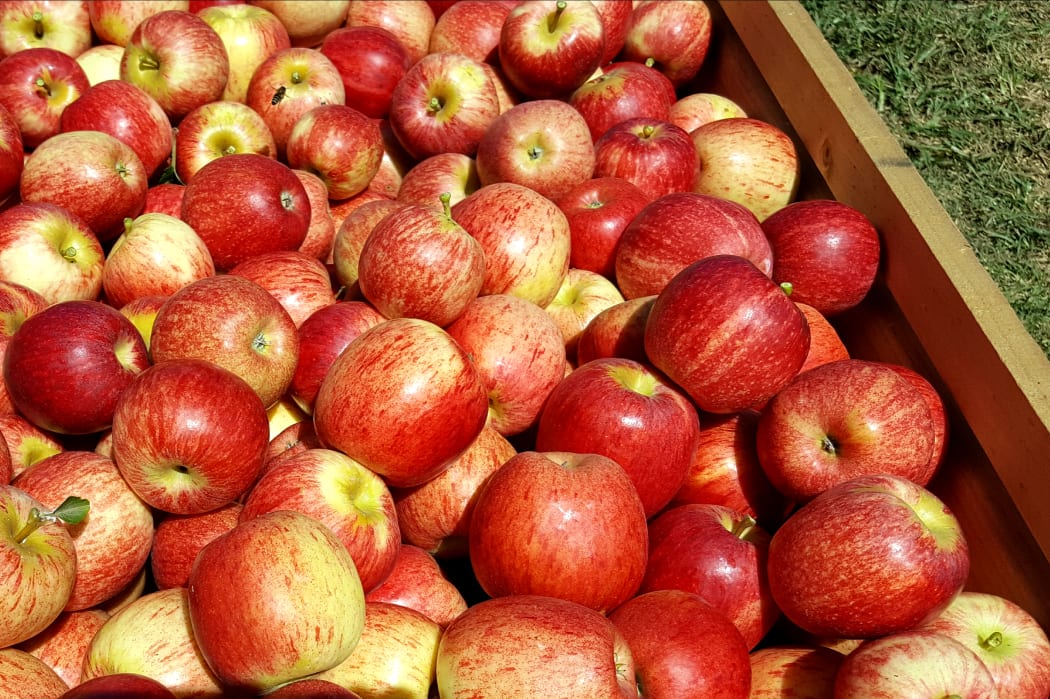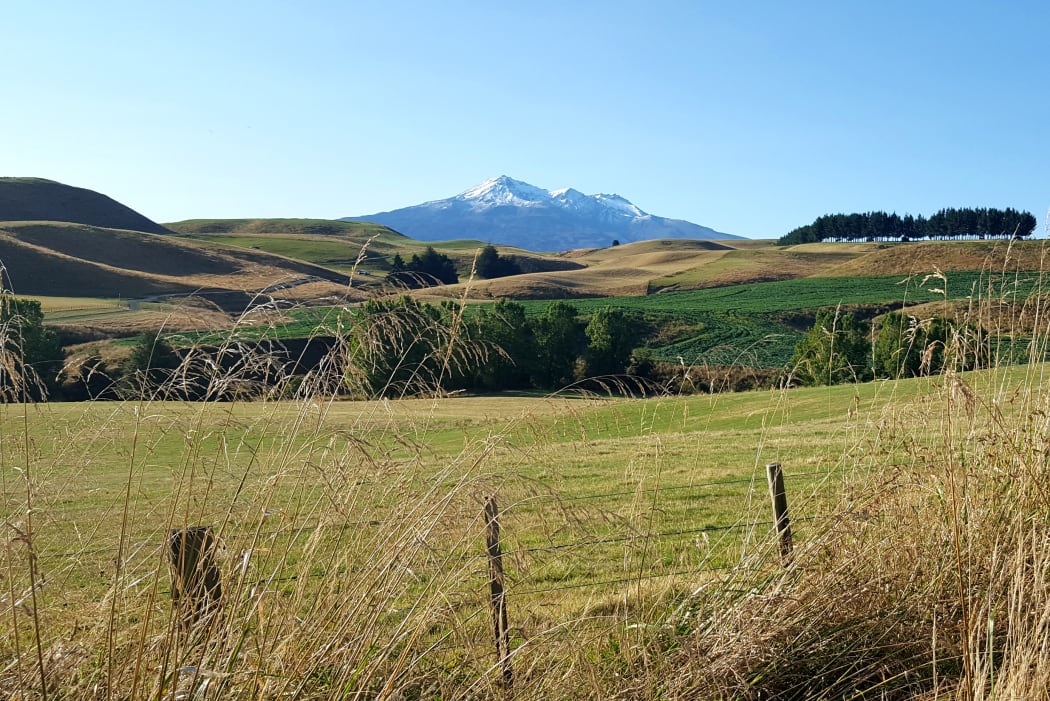
Photo: RNZ/Carol Stiles
The tomato harvest is coming to an end in Gisborne, maize silage is being cut across the North Island and in south Otago, shearing continues. Check out what is happening on farms and orchards around New Zealand from our Country Life team.
Northland had some rain last week but not as much as forecast - it ranged from 17 millimetres in some spots to 60. Milk production is going backwards and follow up rain is critical - although there's none in the forecast. Dairy farmers are looking at recruiting staff for the new season starting on June 1. There is a shortage of skilled people so they don't want to leave it to the last minute. Pregnancy results are in for dairy herds. In some just four percent have failed to get in calf and in others it's up to 20 percent. The ag consultant we speak to says farmers need to dig through and try and work out what worked or what didn't for their cows.
Pukekohe had 12 mm of rain earlier in the week which did help some crops but then windy days soon dried the ground out. Some potato growers have lost up to half their crops because of damage from the tuber moth. Onion growers are busy preparing export orders and the kiwifruit industry is advertising lots of jobs.
Smidgeon of rain
Waikato had a smidgeon of rain at the weekend - between 10 and 15 millimetres and the short story is - it was nowhere near enough. Farmers were hoping for 100 mm. It has gone from being dry to very dry and farmers are now actively looking to get rid of surplus stock. They are feeding out heavily but need to keep in mind whether they'll be leaving enough in the cupboard from winter and next summer. The maize harvest is underway - almost two weeks early. There will be reasonable yields but the silage crop will have lower energy than hoped because it's been too dry for the cobs to fill out nicely.

Photo: RNZ/Susan Murray
The Bay of Plenty has had some much appreciated rain but the order has gone out for some more. Green kiwifruit is looking happy. Dairy farmers are pleased with Fonterra's lift in forecast milk price but not so happy with the drop in dividend.
It has been a bit cooler in King Country. Northern King Country soaked up about 30 to 40 mm of rain at the weekend and Taumarunui a bit more. People have been worried about facial eczema spore counts taking off following the rain but the cool mornings seem to have held them at bay. Feed is steadily disappearing.
Pregnancy tests
Central Taranaki dairy farms could do with some rain. There were a few showers last Friday but a follow up is needed as grass growth rates are down to 20 kilos per hectare a day. Farmers that have completed pregnancy testing are culling any empties, while some farms are going to 16 hour or once a day milking.
Other North Island farmers won't want to hear this but Gisborne had another really good week with rain and some cracker days too. The tomato harvest is coming to an end. There are heaps of squash for sale around the district at really good prices - a dollar a squash - and if you know someone who knows someone - you can take a trailer into a harvested squash paddock and pick up the unwanted or broken squash and take it home to your pigs. Sheep and beef guys are happy - there is still lots of feed around and it is getting cooler which makes working outside a lot easier.
Fabulous weather for apples
Hawkes Bay had some fabulous weather for apples - three nights in a row the temperatures dropped into the single digits which is just what you need for the apples to colour up. Sugars are down though because of the rain early in the season. Royal gala is still coming off. Jazz starts next week. There were 40mm of rain at the weekend so we are told sheep farmers are like dogs with two tails.
The temperature has plummeted in Wairarapa this week - it was only two degrees on Friday morning. Sheep that have been given a haircut at the Golden shears will have noticed the change.

Photo: RNZ/Susan Murray
Back across the range, Manawatu was looking very brown but lots of sheep were outside woolsheds under perfect skies waiting for a shear.
Horowhenua was lucky enough to get 55 mm of rain last week so pasture growth picked up. The early maize silage crop is coming off - this is earlier than usual.
South Island
The Nelson/Motueka region is a drought declared zone. Water restrictions are at 35 percent of allocated water, this means about 10 mm per hectare per week. Vegetable growers have cancelled planting winter veges; the dry hot weather has impacted on the size of apples coming off the trees and some greenhouse growers have been trucking in water from as far afield as Lake Rotoiti for tomatoes, cucumbers and peppers. Sheep and beef farmers are de-stocking due to a lack of water. There's a lot of stress and worry about the impact of the drought on livelihoods. The region's also had the most extreme fire days on record.
Desperate for water
A good dose of rain is needed in Marlborough too. Many vineyards are desperate for water. The southern Valley Water Scheme's been off now for close to a month so water tankers can be seen going from vineyard to vineyard. Fruit's coming off up to 10 days earlier than usual - but yields will drop if grapes are water stressed. Sheep farmers are getting ewes ready for the ram - one farmer's feeding them pea and lucerne baleage, a high protein diet that gets ovulation rates going.
It's still very dry up the Grey Valley on the West Coast. A few millimetres are forecast for next week but more is needed for pasture growth. To keep milk production levels up dairy farmers are feeding out silage, baleage and grain. Paddocks are being sown with new grass and pregnancy testing continues.

Photo: RNZ/Carol Stiles
A great rain arrived last weekend in Canterbury - particularly on the upper plains and parts of North Canterbury where 50 plus millimetres fell. Many other parts only received 10-20 and are looking for more. With lower temperatures and some rain, pasture growth is on the improve. Temperatures over the last few weeks have been too high for rye grass-based pastures, so growth rates have been low for the time of year. This has resulted in many farmers having to feed out. The bulk of the arable harvest is now complete with only later crops such as radish and carrot seed still to go.
Lower feed quality
South Otago had 10 mm of the wet stuff on Wednesday and it was welcomed by all as feed quality was down because of the dry. Fortunately winter crops seem to be in good order though. Sheep farmers are getting ready to flush ewes for mating and there's still a bit of shearing going on.
A dairy farmer near Invercargill in Southland says he's had a bit of moisture this week, 12-13 millimetres, so enough to keep the grass growing but a bit more would be handy. Dairy cow pregnancy results are in and he's reasonably pleased with a 10 percent empty rate. Oats, wheat and barley are being harvested and the last of the paddocks are being re-grassed for light winter grazing and calving.

